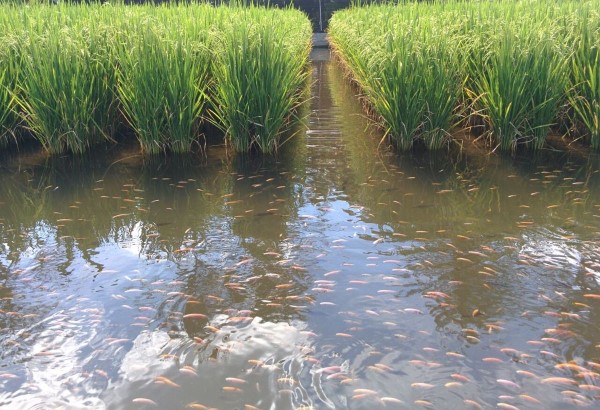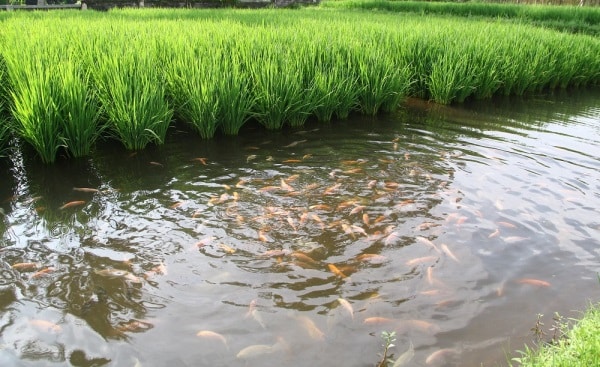Integrated Rice and Fish Farming:

Introduction of Integrated Rice and Fish Farming:- Well, what is integrated fish culture in paddy fields? It is nothing but growing fish in rice (paddy) fields by using the same area without impacting of rice quality and yield. Integrated fish farming provides the option for getting extra income along with main crop (rice). Though this system has proven profitable, it has its own advantages and disadvantages. Rice and fish farming is widely practiced in Asian countries when it compared to western counties.
Advantages of Integrated Rice and Fish Farming:- The following are the advantages of integrated rice and fish farming.
- Farmers can get extra income from rice-fish culture along with main crop yield.
- Rice-fish culture controls insects which are harmful to paddy (rice).
- Rice-fish culture reduces the risk of crop failure.
- Rice-fish culture is useful in controlling weeds.
- Rice-fish culture increase the production of rice as fish stir up soil nutrients which are very helpful for rice crop.
Disadvantages of Integrated Rice and Fish Farming:- The following are the disadvantages of integrated rice-fish culture.
- Rice and fish farming requires restricted use of pesticides.
- This integrated system of fish and rice requires more water than paddy (rice) cultivation alone.
- Rice yield is less in this system as trenches are required about 45 cm below the paddy bottom. Due to these trenches, the paddy cultivation area will be reduced and it results in lower yields. Digging trenches makes difficult in draining the water.
- In rice and fish farming integrated system, water regulation is important and paddy fields cannot be dried while fish is stoked in the field.
- The fish size is small and total production of fish produced in paddy-fish culture is less when compared to open pond fish farming.
- Commercially rice-fish culture many not be feasible as fish must be harvested along with paddy harvesting. This makes very difficult in marketing the fish.
- Most of paddy fields are irrigated by common water channels and it is very difficult to check for water quality/pesticides.
- Growing fish in paddy fields may require more investment then rice culture alone.
- Rice and fish farming requires more labour then paddy cultivation alone.
Site selection for Integrated Rice and Fish Farming:- Site selection also plays an important role in rice and fish farming in paddy fields.
- It requires about 70 to 80 cm rainfall which is considered as optimum for this integrated system.
- Fields having uniform contour and high water retention capacity are most preferred soils in paddy-cum fish culture.
- Good drainage system is one of the important factors to be considered while selecting the site for integrated farming system.
- Selection of site should be free from flooding areas as stocked fish try to escape from the fields.
Types Fish Suitable for Integrated Rice and Fish Farming:- Well, what type of fish species are suitable for integrated paddy system? One should select fish species that can tolerate shallow waters which are less than 14 cm depth and high temperatures up to 38 °C. These fish also should capable of tolerating low dissolved oxygen & high turbidity. The following fish species can be cultured in paddy fields. The depth of water and duration of paddy field, and rice cultivar plays the major role in selection of species in integrated system.
- Common carp or Mrigal (Paddy-cum-carp culture).
- Catla (Paddy-cum-carp culture).
- Tilapia (Paddy-cum-carp culture).
- Rohu (Paddy-cum-carp culture).
- Catfish (Paddy-cum-air breathing fish culture).
Note: Apart from this, Prawn (Shrimp) can also be cultured in paddy fields.

Paddy Preparation, Management in Rice and Fish Farming:- If you are planning for fish culture in paddy fields, the traditional rice fields need modification for better fish shelter and harvest area. These paddy fields are required to have trenches (deepened areas), channels, canals or sumps. These trenches in rice field provide best practices for successful paddy-fish culture. These are extremely helpful when water levels are low, to find the food in passageways, and easy way of fish collection when rice field is drained. When it comes to rice cultivars, deep water varieties are best for paddy and fish culture system.
Trenches (deepened areas) should be made about 0.5 meter deep and minimum of 1 meter wide. Make sure to the trenches should be within 10 meter range from the paddy. For maximum yield of ice, make sure to have trench are should not be more than 10% of the paddy area. After stocking the fish, a water depth of 10 to 15 cm should be maintained for fish survival. Another important practice of rice-fish culture is water from the field should be free from toxicants (insecticides). Don’t go for this concurrent rice-fish culture if any chemicals are mandatory in rice cultivation.
Fertilization Schedule in Rice and Fish Farming:- It is recommended to supplement the paddy fields with well rotten farm yard manure (FMY) like cow dung or any organic compost @ 25 tonnes/ha as a basal application. In the integrated system, deep water paddy requires higher nutrient values, inorganic fertilizers recommended are nitrogen and potassium at 50 kg/ha. These fertilizers (‘N’ and ‘P’) should be applied in different phases like at planting, tilling and flowering. Avoid any pesticides/insecticides/chemicals.
Fish Management in Rice and Fish Farming:- The main management activities of fish culture in paddy fields are given below and these basically depend on fish species, stocking density and location.
- Fish stocking.
- Feeding.
- Fertilization.
- Water quality control.
- Harvesting of fish.
- Re-stocking.
Fish culture may be carried out in 2 ways; concurrent / simultaneous culture and rotation culture. In concurrent culture, both paddy and fishes are grown together where as in rotation culture, fishes and rice are cultivated alternately. The rice field is converted into a temporary fish pond after the harvest. The stocking density and yield of fish varies for both systems. Rotation culture has more advantages over concurrent culture.
Common Carp is the main fish species cultured in most of the paddy fields. It’s up to the farmer to go for just mono fish culture or mixture of fish. However, most of the Asia countries follow different way of fish culture in rice fields. Usually, paddies have trenches (peripheral) of 30 to 45 cm deep, dikes of 25 cm high, bamboo pipes and screens at water inlets and outlets. Fish may be stocked after 1 week of rice transplantation. Fish stock density depends on the type, age of fish and location. Fry/Fingerlings (Carp or Tilapia) of 1 cm size should be stocked in the rice field. On an average fish fry density of 3000 to 4000 to may be stocked per 1 hectare. Rice field water depth should be regulated between 7 cm to 18 cm during fish culture in it. Fish can be given with supplemental feeding at 5% of fish biomass per day. This feed can be composed of soybean meal (10%), copra meal (20%) and rice bran (70%).Rice field may be drained out to check the fish (sample fish growth assessment) growth after 30 days and they should be refilled and re-stocked back in the paddy field. Generally fish growing period is around 70 to 100 days. Fish must be harvested 1 week before rice harvesting. When it comes to yield, it depends on many factors like type of fish, feeding, survival rate, and water quality. On an average one can expect a yield of 200 to 300 kg/ha within 100 days of growing period. The weight gain depends on nutrients available in the field as well as supplemental feed input. One can go for mixed culture with common carp fry, yearling common carp fry and gold fish fry.